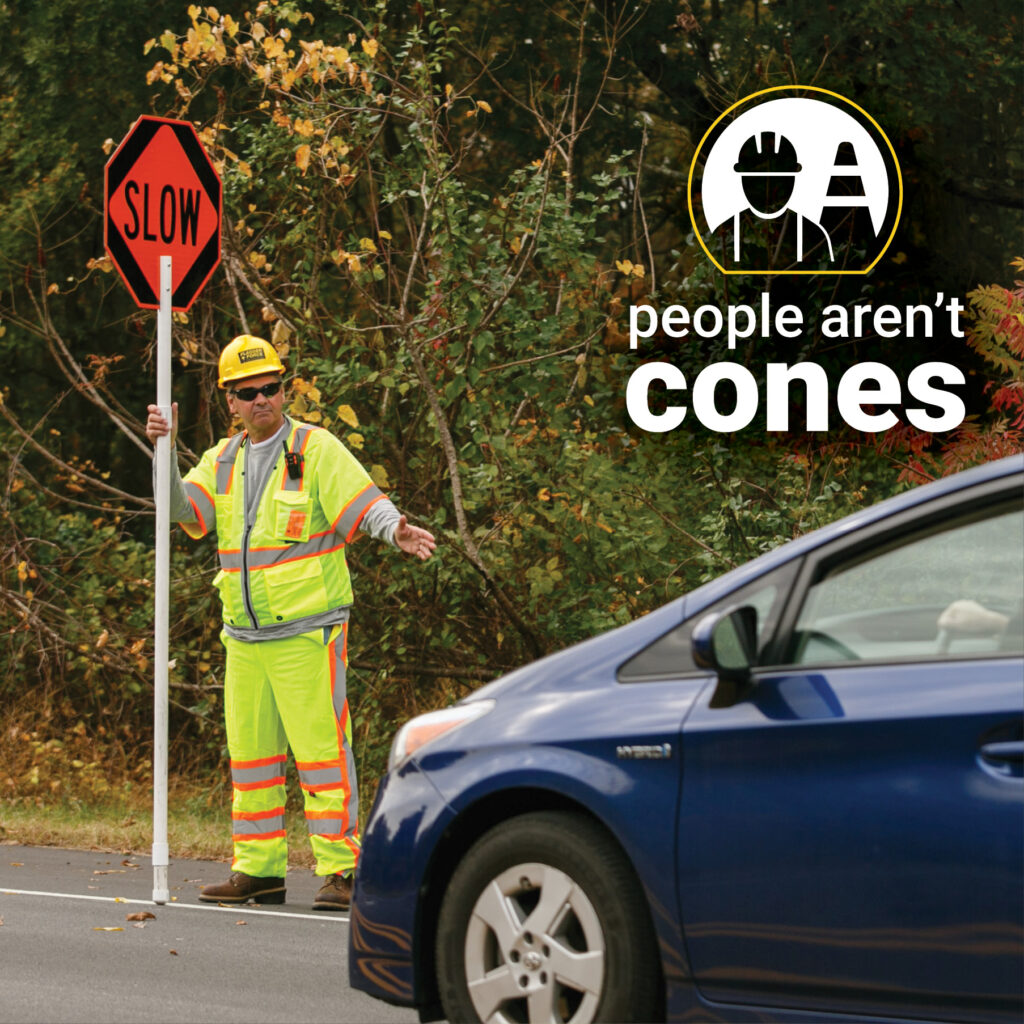Every day, drivers pass through work zones aided by cones, barrels, warning signs, and various pieces of equipment. These devices are essential—they set boundaries, guide traffic, and provide structure. But they can’t anticipate when a driver is distracted by their phone or when a car begins to drift toward the lane closure. Cones can’t react to prevent an accident or tragedy. People can.
At Flagger Force, we know safety in work zones depends on the human factor: trained professionals who use visibility, adaptability, and real-time judgment to protect motorists, clients, and themselves. That’s the core message of our “People Aren’t Cones” campaign—because the men and women in safety gear aren’t equipment. They are people with families, lives, and the skills to make split-second decisions that save lives.
The Science of Visibility
Work zones are designed to grab a driver’s attention, but people process humans differently than static objects. Bright colors, reflective materials, and motion are all proven to catch the eye. That’s why our crews wear full-body, high-visibility yellow personal protective equipment (PPE) and retroreflective gear that stands out in all conditions. As Luke Lazar, Vice President of Risk and Safety, explains, “Color and motion matter. A worker in full-body, high-visibility gear who steps, signals, or raises a paddle is impossible to ignore in a way that cones and signs aren’t.”
Whether it’s dawn glare, nighttime conditions, or a sudden weather shift, trained professionals amplify their own visibility with purposeful movement and signaling. That extra layer of attention-capturing presence can give drivers the precious seconds they need to slow down or steer clear of a work zone.
Risks in Traffic Control
Research and data compiled from over a million work zones proves that most serious injuries and fatalities in the traffic control industry occur during set up and tear down. Once a work zone is established to standards, the hazards to employees dramatically decline. Luke states, “When we have a site properly established, traffic flow is smooth, employees are safe, and the client can perform their work. When it’s not properly set up, traffic will quickly inform you—horns honking, frustrated motorists, and employees that are uneasy.” Flagger Force focuses on reducing time in the set up and tear down processes, using best practices. Often less can be safer, as the time to add additional equipment, such as automated flagger assistance devices (AFADs) or portable temporary rumble strips, places our employees in harm’s way for longer periods of time, without delivering substantial safety to our team members.
Why People Make the Difference
Even in a carefully planned work zone, conditions can change instantly. A driver may ignore the signs or brake too late. A lane shift may cause confusion. That’s when the human factor is critical. Luke notes, “You can line a roadway with devices, but without trained people to manage the unexpected, you’re relying on equipment that can’t think, react, or protect itself.”
Our crew members and leaders are constantly reading the road. They pick up on driver behavior, anticipate risks, and adjust accordingly. For example, a flagger who sees a driver weaving can signal earlier, step back to a safer position, and/or alert the crew depending on the situation. A cone, barrel, or even machinery like an AFAD has limits. These devices can support a work zone, but can’t read a driver’s body language or anticipate the unexpected the way a trained person can.
Our traffic control professionals possess skills reinforced through continuous training. At Flagger Force, every field professional learns how to set up a safe work zone and stay alert to subtle changes: eye contact with drivers, body language cues, and the rhythm of traffic flow. Those human observations transform a static work zone into a dynamic, responsive environment.
How Devices, Technology, & People Work Together
Cones, signs, and lights provide structure in work zones. Technology, such as arrow boards and sequential lights, enhances visibility. But even with every device in position, the system isn’t complete without trained people. Luke explains, “A safe work zone is never about just one element. It’s cones, signs, lights, aided by equipment as needed—and most importantly, people. Without the human factor, the other pieces don’t add up. That human factor ties everything together, providing judgment and adaptability in situations that equipment alone can’t address.”
To illustrate this concept, it can be helpful to visualize the elements of safety working in tandem, with people bringing the adaptability and protection that make the system work.
Respect the Human Factor
Traffic control is often viewed as a logistical step in construction or utility work, but at its core, it’s about protecting lives. The people behind the cones are sons, daughters, parents, and neighbors. They put on their gear each day, knowing they carry the responsibility of protecting not only themselves but also the crews working behind them and the motorists passing through.
Our “People Aren’t Cones” campaign calls on everyone, from our clients and team to motorists and community members, to recognize and respect the human factor in work zones. The individuals behind the cones bring training, experience, and instinct to an environment that can change in a split second.
At Flagger Force, we are proud to be Safety-Driven®, building layered protection into every job site and empowering our crews to bring their training and judgment to the forefront. Because at the end of the day, traffic control is about people—professionals who put their expertise to work so everyone gets home safely.
